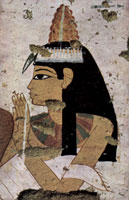
The Ancient Egyptians loved beautiful fragrances. They associated them with the gods and recognised their positive impact on health and well being. Perfumes were generally applied as oil-based salves, and there are numerous recipes and depictions of the preparation of perfume in temples all over Egypt.
The god of perfume, Nefertum, was also a god of healing who was said to have eased the suffering of the aging sun god Re with a bouquet of sacred lotus. He could be described as the world’s first aromatherapist!


Egypt was the world leader in the creation of perfume and was closely associated with the international perfume trade. When Julius Caesar took control of Egypt, he demonstrated this fact to the Roman people by throwing bottles of precious perfume to the crowd during his triumphant return to Rome.

The most highly prized perfumes of the ancient world came from Egypt. Of these, arguably the most popular were Susinum (a perfume based on lily, myrrh, cinnamon), Cyprinum (based upon henna, cardamom, cinnamon, myrrh, and southernwood), and Mendesian (myrrh and cassia with assorted gums and resins). Mendesian was named after the ancient city of Mendes, and although the perfume was produced in other locations at a later date, the best variety was still thought to be that from Mendes.
They also loved Stakte, a perfume with a fairly strong aroma of myrrh, Rhondinium (based on the highly popular scent of rose), and a scent simply known as “the Egyptian” which seems to have been based on cinnamon and myrrh with sweet wine.



Perfumes were generally stored in beautiful alabaster bottles. These varied widely in design, often taking their inspiration from nature. There is also some evidence that blue glass bottles may have been used at times.
Bibliography
- Sacred Luxuries: Fragrance, Aromatherapy, and Cosmetics in Ancient Egypt (1999) Lise Manniche
Copyright J Hill 2015